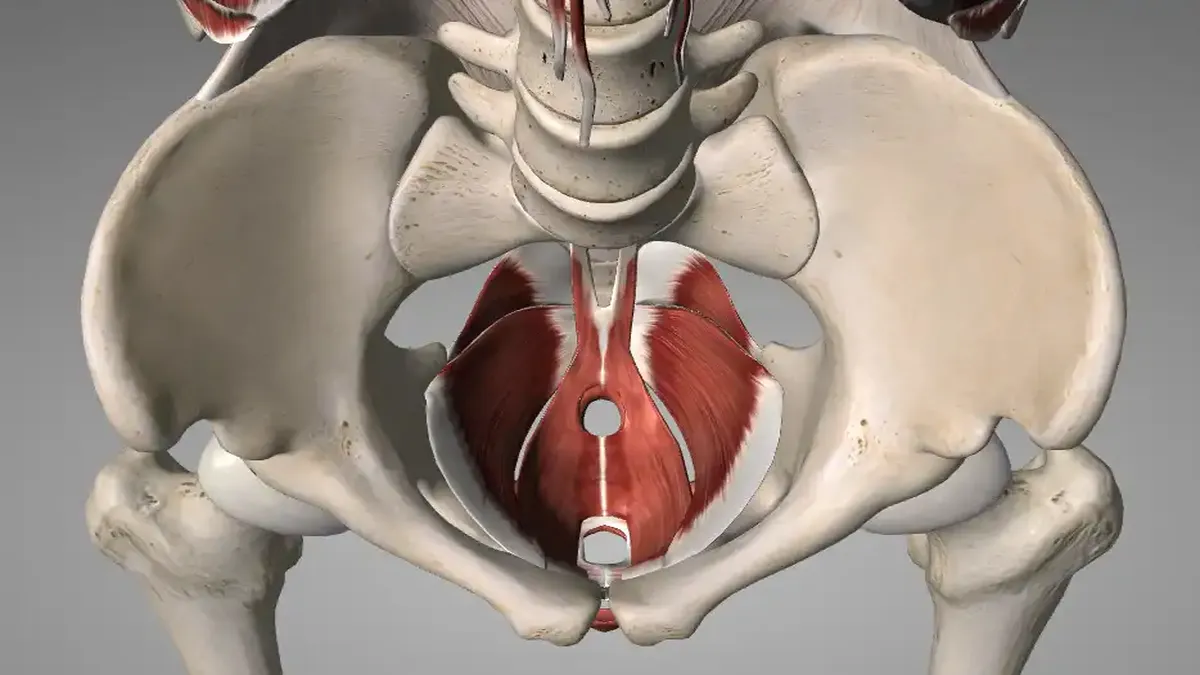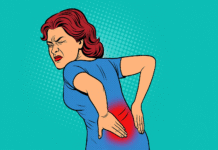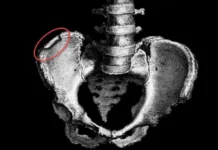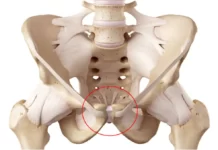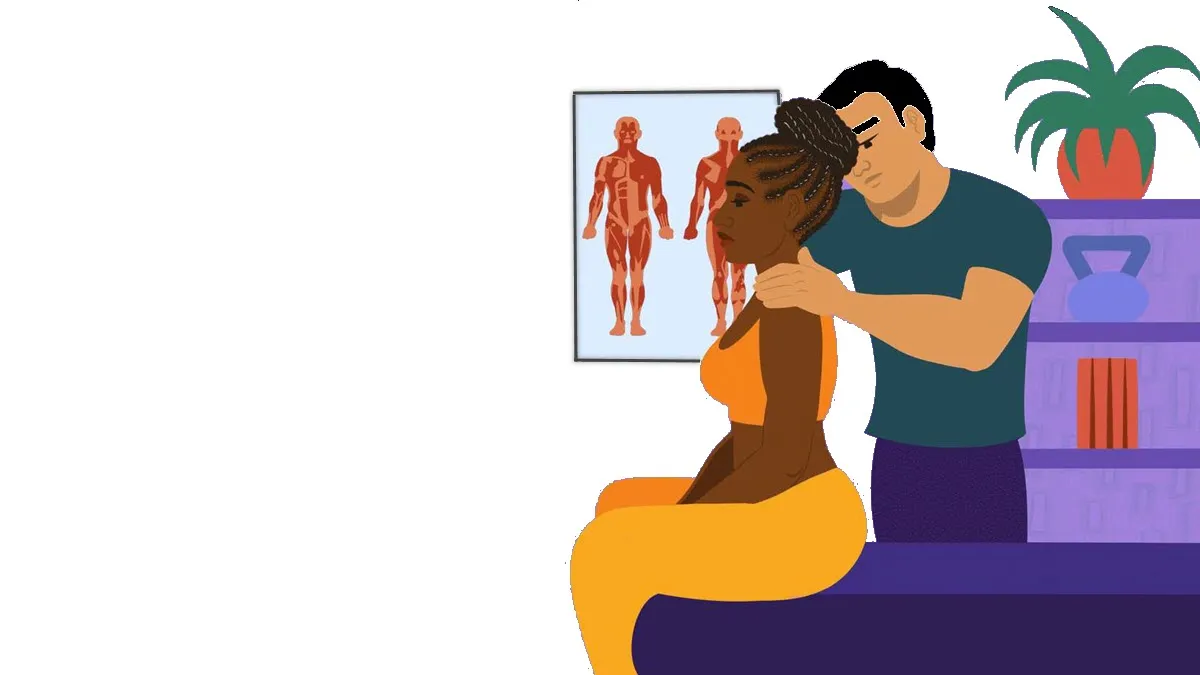Levator ani syndrome is a pelvic floor dysfunction characterized by permanent contraction of the muscles that support the rectum, bladder, and in women, the uterus and vagina.
Introduction
Levator ani syndrome, also known as levator ani syndrome, is characterized by muscular dysfunction in the levator ani muscle, an essential component of the pelvic floor. This condition gives rise to various symptoms such as pain in the rectum or coccyx region, disturbances in intestinal transit, as well as a sometimes heavy feeling or pressure in the pelvic region.
The pelvic floor region represents a complex anatomical area where muscles and nerves intertwine, thus posing a significant challenge for the diagnosis of pelvic pain. This complexity makes it difficult to distinguish between various sources of pain, whether organs, muscles or nerve branches, all coexisting within centimeters of each other. As the most complex region of the pelvis, the pelvic floor supports all of the pelvic organs as well as the abdominal contents.
The levator ani muscle, embedded in the pelvic floor, can develop myofascial pain syndrome, often associated with repetitive strain injuries, postpartum injuries, or blunt trauma. This syndrome mainly causes pain in the pelvic floor, sometimes radiating towards the buttocks and legs.
The dysfunctional genesis of levator ani syndrome, or levator ani, can manifest as a weakened or too strong levator ani, each leading to specific manifestations. A weakened levator ani can lead to pelvic organ prolapse, while an overly contracted levator ani can cause difficulty filling or emptying the intestines. Causes of this syndrome include muscle spasms, pelvic floor disorders, stress, infections, trauma, neurological disorders, gastrointestinal problems, and sometimes genetic factors.
Symptoms include anal or rectal pain, muscle spasms, difficulty defecating, pain during defecation, feeling of rectal pressure, frequent need to urinate, and discomfort while sitting. Treatment may include osteopathy, which aims to assess and correct muscular imbalances, perform joint manipulations, recommend specific exercises and provide advice on posture and daily movement.
The pelvic floor also participates in functions such as breathing, posture and spinal support. The complexity of this anatomical region makes the diagnosis of pelvic pain difficult, as several potential sources of pain coexist in a small space.
Pelvic floor disorders, such as levator ani syndrome, can result from a variety of factors such as trauma, muscle tension, neurological disorders, infections, and even genetic predispositions. Managing these disorders may require a multidisciplinary approach, including interventions like osteopathy to treat muscular imbalances and restore normal pelvic floor function.
In summary, the pelvic floor represents an essential anatomical structure with crucial implications for health and well-being. Its role in maintaining vital bodily functions highlights the importance of understanding and managing problems that can affect this complex anatomical region.
Anatomy and Function of the Levator Ani Muscle
The levator ani muscle, also known as the levator ani muscle, is an important muscle of the pelvic floor. Its location, structure and function are crucial for several physiological functions, including rectal continence and support of the pelvic organs. Let’s explore these aspects in detail:
- Localisation :
- The levator ani muscle is part of the pelvic floor muscle group.
- It extends in a horseshoe shape around the anus and coccyx.
- It is made up of two main parts: the pubococcygeus (anterior) and the iliococcygeus (posterior).
- Structure :
- The levator ani muscle is made of striated muscle fibers, meaning it is under voluntary control.
- The muscle fibers are arranged to form a ring around the anus.
- The anterior part, the pubococcygeus muscle, originates from the pubis, while the posterior part, the iliococcygeus muscle, originates from the fascia of the obturator internus muscle and the medial part of the sacrospinous ligament.
- Function :
- Sphincteric Control: The levator ani muscle is essential for sphincteric control of the anus, thereby contributing to rectal continence.
- Pelvic Organ Support: It plays a crucial role in maintaining the pelvic organs, including the bladder and rectum.
- Participation in Sexual Functions: This muscle also participates in sexual functions by contributing to rhythmic contractions during orgasm.
- Postural Support: It offers postural support by helping to maintain the position of the pelvic organs in the abdominopelvic cavity.
- Innervation :
- The levator ani muscle is innervated by branches of the pudendal nerve, particularly the dorsal pudendal nerve.
- Role in Pelvic Function:
- It works synergistically with other pelvic floor muscles to maintain the structural and functional integrity of this region.
- Coordinated contractions and relaxations of this muscle are essential for functions such as defecation and urination.
- Alterations and Dysfunctions:
- Malfunctions of the levator ani muscle can contribute to problems such as fecal incontinence or urinary continence disorders.
- Excessive tension or trigger points in this muscle may be associated with chronic pelvic pain.
In summary, the levator ani muscle is a key player in the pelvic floor, exerting precise control over sphincter functions and contributing to the support of the pelvic organs. Its anatomical and functional understanding is essential for health professionals, including osteopaths, in the management of disorders
The Pelvic Floor: Understanding Its Importance
The pelvic floor is a complex anatomical region located at the base of the pelvis, composed of muscles, ligaments, and connective tissues. This structure plays a crucial role in maintaining and supporting pelvic organs such as the bladder, uterus (in women), and rectum. The function of the pelvic floor is multifaceted, involving aspects related to urinary and fecal continence, support of internal organs, as well as participation in sexual activities.
The pelvic floor muscles are often compared to a “hammock” that supports the internal organs, and they are essential for maintaining continence and avoiding problems with prolapse, where organs can descend from their normal position.
Among the key muscles of the pelvic floor is the levator ani muscle, which is part of the muscle group called the levator ani. This muscle, often associated with levator ani syndrome, plays a crucial role in maintaining the tension needed to support the pelvic organs while preventing excessive contraction that could compress blood vessels and nerves.
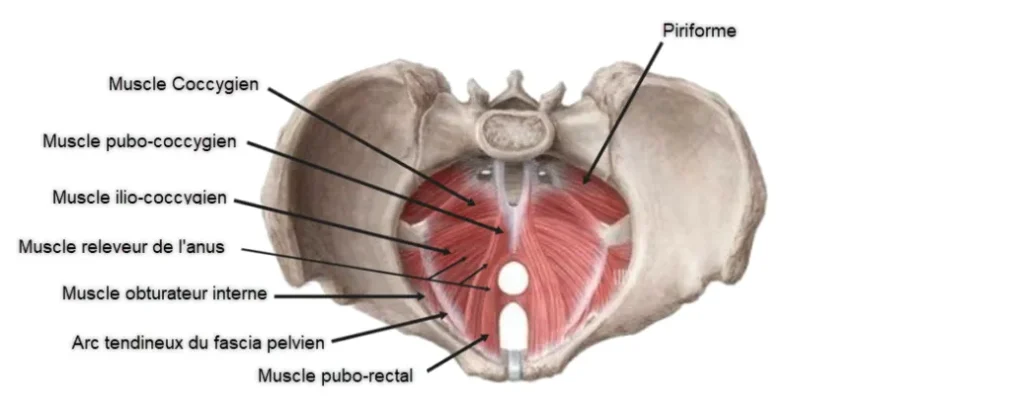
When considering the pelvic floor muscles, the levator ani is a relatively small player on a large team. Its role is relatively simple: to provide support to maintain the pelvic organs. The levator ani is not a single muscle but rather a name given to a group of 3 muscles located on either side of the pelvic floor:
- Pubo-coccygien
- Ilio-coccygeus
- Pubo-rectal
Myofascial Syndrome of the Levator Ani Muscle
This syndrome, often triggered by repetitive strain injuries, can be associated with activities such as mountain biking and horseback riding. Additionally, injuries resulting from childbirth or blunt trauma may play a role in its development. A distinctive feature is the presence of myofascial trigger points, local areas of intense sensitivity in the affected muscle. Manual stimulation of these points not only causes intense pain in that specific location, but also referred pain, radiating to other areas of the pelvic floor, lower back or lower extremities.
Various factors can predispose to the syndrome, including occasional strenuous physical activity, poor posture, previous trauma, inadequate diet, and psychological disorders such as chronic stress and depression. These factors, when combined, increase the risk of developing levator ani myofascial pain syndrome.
Symptoms of this condition include deep pain in the anal area, a feeling of pressure or heaviness, pain during or after defecation, and sometimes difficulty controlling bowel movements. Patients may also experience pain during sexual intercourse, significantly impacting their quality of life.
Management of levator ani myofascial syndrome often requires a multidisciplinary approach. Healthcare professionals, particularly osteopaths, play a key role in relieving symptoms. Osteopathic techniques specifically aim to release muscular tension, improve mobility, and restore the functional balance of the levator ani muscle.
Understanding the complex characteristics of this syndrome allows healthcare professionals to design personalized treatment plans, tailored to each patient. With a focus on holistic management, these approaches aim to improve the quality of life of affected individuals and restore normal function of the levator ani muscle.

Dysfunctional Genesis of Levator Ani Syndrome
Levator Ani Syndrome finds its origin in a dysfunctional genesis of the levator ani muscle, also known as the levator ani. This complex condition can be characterized by two extremes: too weak levator ani or too strong levator ani, each associated with specific manifestations.
Levator ani too weak:
When the levator ani is weakened, the pelvic floor muscles become excessively lax, which can lead to pelvic organ prolapse. In women, this may manifest as the cervix or uterus descending into the vagina. This condition can cause a variety of symptoms, including back pain, problems urinating or defecating, and painful intercourse. Additionally, an unsupported bladder can lead to urinary incontinence, adding to the complexity of health issues associated with a weakened levator ani.
Levator ani too strong:
Conversely, an overly contracted levator ani can lead to non-relaxing pelvic floor dysfunction. Because the pelvic floor muscles are too tight, this can lead to difficulty filling or emptying the bowels. Symptoms can include pelvic pain, painful intercourse, and even problems with erectile dysfunction in men.
Causes of Levator Ani Syndrome
The causes of levator ani muscle dysfunction, which can lead to conditions such as myofascial syndrome, are diverse and often multifactorial. A common trigger for this dysfunction is exposure to repetitive strain injuries, often associated with activities like mountain biking and horseback riding. These repetitive movements can put excessive strain on the muscle, leading to tension and imbalances.
Furthermore, trauma resulting from childbirth can play a significant role in the development of levator ani muscle dysfunction. Stress placed on this region during childbirth can lead to muscle damage and tension, contributing to the emergence of symptoms associated with myofascial syndrome.
Another notable risk factor is the presence of blunt trauma to the pelvic region. These traumas can disrupt normal muscle function and trigger prolonged muscle tension responses. The consequences of these traumas can be varied, ranging from the formation of myofascial trigger points to more profound alterations in the function of the levator ani muscle.
In addition to trauma, several other elements can predispose to dysfunction of the levator ani muscle. People who occasionally engage in intense physical activities may be more prone to these dysfunctions, as may those who adopt poor posture, whether in front of a computer or television. Previous trauma, leading to abnormal muscle function, can also contribute to the genesis of this syndrome.
Lifestyle risk factors, such as an unbalanced diet, may also play a role in the development of muscle dysfunction. Additionally, psychological disorders like chronic stress and depression have been associated with an increased risk of developing levator ani muscle symptoms. These psychological conditions can contribute to exacerbated muscle tension, creating a favorable environment for myofascial syndrome.
- Muscle spasms: Involuntary and excessive spasms of the levator ani muscle are the main feature of this syndrome. These spasms can be triggered by muscle tension, trauma or irritation.
- Pelvic Floor Disorders: The levator ani muscle is an integral part of the pelvic floor. Pelvic floor disorders, such as pelvic dysfunction, may contribute to levator ani syndrome.
- Stress and tension: Physical and emotional stress can play a role in triggering muscle spasms. People who experience significant stress or emotional tension may be more likely to develop this syndrome.
- Infections: Infections in the pelvic area, such as urinary tract infections or genital infections, could trigger abnormal muscle reactions, contributing to levator ani syndrome.
- Trauma: Physical trauma, such as injuries to the pelvic area or previous surgeries, could cause changes in the function of the levator ani muscle.
- Neurological disorders: Abnormalities in the nervous system, such as nerve damage or neurological disorders, could influence muscle function and contribute to the syndrome.
- Gastrointestinal problems: Certain gastrointestinal problems, such as chronic constipation or intestinal disorders, can put increased pressure on the levator ani muscle, leading to spasms.
- Genetic Factors: Although less common, genetic predispositions may play a role in susceptibility to developing muscular disorders like levator ani syndrome.
Symptoms of Levator Ani Syndrome
Symptoms associated with the levator ani muscle, when dysfunctional such as myofascial syndrome, can result in a variety of uncomfortable manifestations that impact the quality of life of affected individuals. These symptoms are often complex, involving both local sensations in the anal region and pain referred to other parts of the body.
At the local level, affected patients may experience deep pain in the anal region, characterized by a feeling of pressure or heaviness. These unpleasant sensations may be exacerbated during or after defecation, creating significant discomfort. The presence of myofascial trigger points in the muscle can also contribute to severe localized pain when stimulated manually, through pressure or stretching.
One of the most common symptoms is difficulty controlling bowel movements. Malfunctions of the levator ani muscle can disrupt the normal functioning of this muscle, which is essential for controlling intestinal movements. This difficulty can lead to episodes of fecal incontinence or, on the contrary, periods of constipation, thus altering the regular functioning of the digestive system.
The symptoms can also have repercussions on the sexual sphere, with pain during intimate intercourse. Muscle tension and dysfunction in the levator ani muscle region can lead to discomfort during sexual activity, leading to emotional and relational implications for affected individuals.
It is important to note that symptoms are not just limited to the anal area. Pain can often spread to other areas, affecting the lower back, buttocks and even lower extremities. This radiation of pain, known as referred pain, is a distinctive feature of levator ani myofascial syndrome. These widespread symptoms can worsen the mobility and overall quality of life of affected individuals.
Levator ani muscle myofascial syndrome can also lead to prolonged muscle tension, exacerbating symptoms and contributing to a spiral of pain. Triggering factors, such as trauma, infections, gastrointestinal disorders, emotional stress, and poor eating habits, play a role in maintaining this muscle dysfunction, requiring a comprehensive management approach.
- Anal or rectal pain: People with levator ani syndrome may feel severe pain around the anus or inside the rectum. This pain can be acute or chronic.
- Muscle spasms: Involuntary spasms of the levator ani muscle are a major feature of this syndrome. These spasms can cause a feeling of tightness or pulling.
- Difficulty defecating: Muscle spasms can cause difficulty expelling stool during defecation. This can lead to constipation or incomplete bowel movements.
- Pain during defecation: Sufferers may experience increased pain during episodes of defecation due to excessive muscle contractions.
- Sensation of rectal pressure: Some individuals may experience a feeling of pressure or heaviness in the rectal area.
- Frequent urge to urinate: Levator ani syndrome may also be associated with increased frequency of urges to urinate.
- Sitting discomfort: Pain and muscle spasms can make sitting uncomfortable.
Osteopathy
Treating levator ani syndrome with osteopathy can be considered as part of a comprehensive approach to symptom management. Osteopathy is a discipline that focuses on the musculoskeletal system and movement of the body, and some osteopaths may incorporate specific techniques to treat pelvic floor dysfunctions, including those associated with levator ani syndrome.
Here is how osteopathy could be applied in the context of the treatment of levator ani syndrome:
- Assessment: The osteopath will begin with a thorough assessment to understand the medical history, specific symptoms and perform a physical examination. This may include an assessment of posture, pelvic mobility and pelvic floor muscles.
- Correction of muscular imbalances: The osteopath can use gentle manual techniques to work on the muscles of the pelvic floor, seeking to release tension, improve mobility and restore muscular balance.
- Joint manipulations: If mobility restrictions are identified in the joints of the pelvis or spine, the osteopath can perform joint manipulations to restore normal mobility.
- Exercises and advice: The osteopath can recommend specific exercises aimed at strengthening and softening the pelvic floor muscles. Advice on posture and daily movement can also be provided.
Normal Functions of the Levator Ani
The levator ani is a group of muscles located in the pelvic floor region of the body. Comprising the puborectalis, pubococcygeus, and iliococcygeus muscles, the levator ani plays a crucial role in various bodily functions, providing support to the pelvic organs and contributing to urinary, fecal, and sexual function. Understanding the normal functions of the levator ani muscles is essential for maintaining pelvic health and overall well-being.
One of the primary functions of the levator ani muscles is to provide structural support to the pelvic organs, including the bladder, uterus (in females), and rectum. These muscles form a supportive sling-like structure that helps maintain the position and stability of the pelvic organs within the pelvic cavity. Proper functioning of the levator ani is essential for preventing pelvic organ prolapse, a condition in which the pelvic organs descend or protrude into the vaginal canal or rectum due to weakened pelvic floor muscles.
Additionally, the levator ani muscles play a vital role in urinary continence, the ability to control the passage of urine from the bladder. Contraction of the pelvic floor muscles, including the levator ani, helps maintain urethral closure pressure and prevents urinary leakage or incontinence. Strengthening and toning the levator ani muscles through exercises such as Kegels can improve urinary control and reduce the risk of urinary incontinence, particularly in women who have given birth vaginally or individuals with pelvic floor dysfunction.
Furthermore, the levator ani muscles contribute to fecal continence, the ability to control bowel movements and prevent fecal leakage. These muscles help maintain the integrity of the anorectal angle and provide support to the rectum and anal canal, facilitating voluntary control over defecation. Dysfunction or weakness of the levator ani muscles can lead to fecal incontinence, the involuntary loss of stool, and impair quality of life. Pelvic floor rehabilitation, including targeted exercises to strengthen the levator ani, is often recommended as part of the treatment approach for fecal incontinence.
In addition to their roles in urinary and fecal continence, the levator ani muscles are involved in sexual function and satisfaction. Contraction and relaxation of these muscles contribute to vaginal tone and sensation during sexual activity, particularly during orgasm. Strengthening the pelvic floor muscles, including the levator ani, can enhance sexual pleasure and improve sexual health for both men and women.
Moreover, the levator ani muscles play a crucial role in supporting the pelvic girdle and maintaining stability in the sacroiliac joints and lumbar spine. Dysfunction or weakness of these muscles can contribute to pelvic pain, lower back pain, and sacroiliac joint dysfunction. Rehabilitation strategies aimed at restoring optimal function and coordination of the levator ani muscles can help alleviate pelvic pain and improve overall musculoskeletal health.
The levator ani muscle, as a component of the pelvic floor, performs several essential functions to support the pelvic organs and maintain continence. Here is how the muscle should normally function to perform these functions:
- Organ support: The levator ani helps support the pelvic organs, including the bladder, the uterus in women, and the rectum. By working in conjunction with other pelvic floor muscles, it helps maintain these organs in normal anatomical position.
- Sphincter control: The levator ani muscle is directly involved in the voluntary control of the anal and urinary sphincters. It plays a crucial role in continence, allowing a person to retain feces and urine until it is socially appropriate to pass them out.
- Postural support: The muscle contributes to maintaining pelvic posture by supporting the internal organs and helping to stabilize the pelvic region. This stability is important for various daily activities, such as walking, sitting, and other trunk movements.
- Coordination with other pelvic muscles: The levator ani works closely with other pelvic floor muscles, such as the puborectalis muscle and the coccygeus muscle, to provide optimal support and coordination during of different functions, including defecation, urination and maintaining posture.
- Response to intra-abdominal pressure:
When intra-abdominal pressure increases, such as during coughing, laughing, or lifting heavy objects, the levator ani muscle should reflexively contract to strengthen the pelvic floor. This helps prevent descent of the pelvic organs and maintain the integrity of the pelvic region. - Adaptation to trunk movements:
The muscle must also be able to adapt to trunk movements, such as flexion, extension and rotation, maintaining the pelvic stability necessary for these movements without compromising continence function.
In summary, the levator ani muscle functions normally by providing structural support to the pelvic organs, providing voluntary control of the sphincters, helping to maintain pelvic posture, coordinating its actions with other pelvic muscles, and by adapting its contractions to intra-abdominal pressure and trunk movements. Proper functioning of this muscle is essential for overall well-being and the prevention of various pelvic floor-related problems, such as incontinence.
Diagnosis and Evaluation of Levator Ani Syndrome
Diagnosing levator ani syndrome involves a thorough evaluation of symptoms, the patient’s medical history, as well as physical examinations and, sometimes, additional tests. Here is an overview of the diagnostic and assessment methods commonly used to identify levator ani syndrome:
- History and Patient Interview:
- The doctor will begin by collecting detailed information about the patient’s current symptoms, their frequency, intensity and duration.
- Medical, surgical and gynecological history will also be examined.
- Physical Examination:
- A thorough physical examination is essential to assess muscle tension in the pelvic region.
- The doctor may perform a rectal exam to assess the tone of the levator ani muscle and identify possible trigger points.
- Gynecological Examination (in Women):
- Women may undergo a gynecological exam to assess the presence of muscle tension in the pelvic area.
- Neurological Assessment:
- A neurological assessment may be performed to rule out other neurological conditions that may be contributing to the symptoms.
- Pelvic Function Tests:
- Pelvic function tests may be performed to assess muscle coordination and strength in the pelvic area.
- Pelvic ultrasound :
- A pelvic ultrasound may be performed to rule out other possible causes of the symptoms and evaluate the structure of the pelvic organs.
- Pelvic MRI or CT:
- Pelvic magnetic resonance imaging (MRI) or computed tomography (CT) may be recommended to obtain detailed images of the tissues and structures in the pelvic region.
- Provocative Maneuvers:
- Certain specific maneuvers, such as voluntary contraction of the levator ani muscle, can be performed to reproduce symptoms and assess muscle response.
- Consultation with a Specialist:
- A consultation with a specialist, such as an osteopath specializing in pelviperineology, may be recommended for a more in-depth assessment of muscle tension and trigger points.
- Multidisciplinary Assessment:
- Given the complex nature of levator ani syndrome, a multidisciplinary assessment involving healthcare professionals such as urologists, gynecologists, osteopaths and neurologists may be necessary.
Correlation with Other Pelvic Conditions
The correlation between levator ani syndrome and other pelvic conditions, including chronic prostatitis in men, is an important aspect to consider in the evaluation and management of pelvic symptoms. Here is a discussion of potential links between levator ani syndrome and chronic prostatitis:
- Anatomical and Muscular Interaction:
- The levator ani muscle is part of the pelvic floor, a complex anatomical region comprising muscles, ligaments and fascial structures.
- Increased tension in the levator ani muscle can influence overall pelvic function, including the prostate area in men.
- Implications for the Prostate in Men:
- Excessive muscle tension in the levator ani can lead to symptoms similar to chronic prostatitis, such as painful urination, pelvic pain, and sexual dysfunction.
- Studies, such as one conducted at Stanford University Medical School, suggest that trigger points in the levator ani muscle may contribute to symptoms of chronic nonbacterial prostatitis.
- Understanding Symptom Triggering:
- Trigger points in the levator ani muscle can trigger remote symptoms, including prostate pain.
- A thorough understanding of how muscle tension influences pelvic symptoms allows for a more targeted treatment approach.
- Integrated Treatment Approach:
- Healthcare professionals, such as osteopaths specializing in pelviperineology, may use an integrated treatment approach, combining levator ani trigger point release and other interventions to relieve pelvic symptoms.
- Multidisciplinary Assessment:
- When a patient presents with symptoms of chronic prostatitis, a multidisciplinary evaluation involving specialists in urology, osteopathy, and pelvic osteopathy may be necessary.
- Close collaboration between healthcare professionals allows for a holistic understanding of contributing factors and the design of a comprehensive treatment plan.
In conclusion, the correlation between levator ani syndrome and chronic prostatitis highlights the importance of an integrated approach in the assessment and management of pelvic symptoms. A thorough understanding of the interaction between anatomical and muscular structures helps guide therapeutic interventions to improve patients’ quality of life.
The Role of Diet and Lifestyle
The role of diet and lifestyle may play a significant role in influencing the symptoms and treatment of levator ani syndrome. Here is an exploration of these aspects:
- Influence of Diet on Inflammation:
- Certain foods can contribute to overall inflammation in the body, which can worsen the symptoms of levator ani syndrome.
- Sufferers can benefit from an anti-inflammatory diet rich in fruits, vegetables, whole grains, fatty fish and other foods that help reduce inflammation.
- Hydratation Adequate :
- Adequate hydration is essential for the overall health of the body, including that of the pelvic floor.
- Sufficient water consumption can help maintain the elasticity of muscles and tissues, contributing to relaxation of the levator ani muscle.
- Stress management :
- Stress can be a trigger or aggravating factor for pelvic symptoms.
- Stress management techniques, such as meditation, deep breathing, or yoga, may play a role in reducing muscle tension and associated symptoms.
- Adapted Physical Exercise:
- Regular physical exercise, adapted to the individual condition, can help maintain flexibility and muscle strength.
- Pelvic floor strengthening exercises, under the supervision of a healthcare professional, may be beneficial.
- Avoidance of Irritating Foods:
- Some individuals may be sensitive to certain irritating foods, such as spices, caffeine, or spicy foods.
- Identifying and avoiding these food triggers can help minimize symptoms.
- Maintaining a Healthy Weight:
- A healthy body weight helps prevent pelvic floor overload.
- Appropriate nutritional advice can be beneficial in maintaining an appropriate weight.
- Regular Sleep:
- Adequate sleep is essential for tissue recovery and repair.
- Sleep disturbances can contribute to increased muscle tension.
- Professional Consultation:
- Working with a nutritionist or dietitian can provide personalized recommendations for a diet that supports pelvic health.
- Collaboration with health professionals allows lifestyle adjustments based on individual needs.
Osteopathic Approach in Treatment
Osteopathy can play a crucial role in the treatment of levator ani syndrome by addressing the musculoskeletal and functional aspects associated with this condition. Here is a detailed exploration of the osteopathic approach in the treatment of levator ani syndrome:
- In-depth Patient Assessment:
- The osteopath performs a thorough assessment to understand the patient’s medical history, specific symptoms and triggering factors.
- This assessment helps target areas of muscle tension and joint dysfunction related to levator ani syndrome.
- Rebalancing of the Pelvis:
- The osteopath can work on rebalancing the pelvis to relieve pressure on the pelvic floor.
- Specific techniques can be used to realign the pelvis and alleviate muscle tension.
- Release of Muscle Tension:
- Osteopathic manipulations target excessive muscular tension, particularly that of the levator ani muscle.
- Myofascial trigger point release can be incorporated to release areas of tension.
- Work on Joint Mobility:
- The osteopath can use techniques to improve the mobility of the pelvic and sacral joints.
- This helps restore normal joint function and reduce pressure on surrounding muscles.
- Harmonization of Facial Structures:
- Osteopathic manipulations aim to harmonize the fascial structures of the pelvic floor, thus promoting better muscular coordination.
- This can help prevent muscle compensations that contribute to levator ani syndrome symptoms.
- Patient Education:
- The osteopath plays an educational role by informing the patient about the contributing factors to levator ani syndrome and providing advice on postural adjustments and practices favorable to pelvic health.
- Integration with Other Processing Modalities:
- Osteopathy can be integrated with other therapeutic approaches, such as osteopathy, paradoxical relaxation, or behavioral therapy.
- A multidisciplinary approach may offer more comprehensive results in the management of the syndrome.
- Regular Monitoring:
- Osteopathic treatment is often carried out on a regular basis to monitor the patient’s progress and make adjustments accordingly.
- Monitoring allows the treatment plan to be adapted based on the patient’s individual response.
In conclusion, osteopathy can make a significant contribution in the treatment of levator ani syndrome by addressing the physical and functional aspects of the condition. An individualized and integrated approach, combined with patient education, can promote symptom reduction and improve quality of life.
Success Case Studies
- Case of Mr.
- Mr.
- After several osteopathic treatments, including myofascial trigger point release and pelvic rebalancing techniques, Mr.
- The osteopathy sessions helped to release muscular tension, improve pelvic mobility, and provide lasting relief.
- Through postural adjustments and personalized advice, the osteopath also helped prevent the recurrence of symptoms.
- Madame Y’s Case:
- Mrs. Y, a 35-year-old woman, had been confronted with acute pelvic pain associated with levator ani syndrome, impacting her quality of daily life.
- The osteopath used myofascial release and pelvic rebalancing techniques, adapted to the specific needs of Mrs. Y.
- Over the course of the sessions, she noted a significant reduction in pain, an improvement in pelvic mobility, and a reduction in muscle tension.
- Osteopathy also played an important role in educating Mrs. Y on managing stress and triggers related to her syndrome, reinforcing the positive results.
Self-Care Exercises and Techniques
- Pelvic floor stretches:
- Sitting comfortably, contract your pelvic floor muscles for a few seconds, then release.
- Repeat this contraction and release exercise several times.
- While lying down, bend your knees and place your feet flat. Gently contract and lift the pelvic floor, then release.
- Self-massage of the perineum:
- Use your fingers to apply gentle pressure to the perineum, the area between the anus and genitals.
- Use gentle circular movements to release muscle tension.
- Adjust the pressure according to your comfort level.
- Deep breathing exercises:
- Get into a comfortable position, inhale slowly through your nose while expanding your abdomen, then exhale slowly through your mouth.
- Focus on relaxing the pelvic floor as you exhale.
- Repeat this process several times to promote muscle relaxation.
- Yoga and specific stretching:
- Practice yoga poses that promote stretching and relaxation of the pelvic floor, such as the “butterfly” and “brushcutter.”
- Incorporate general stretches that target the muscles of the pelvis and perineum.
- Hot water bottle or cold compress:
- Apply a hot water bottle or cold compress to the pelvic area to relieve pain and inflammation.
- Alternate between heat and cold depending on your preferences.
- Stress management :
- Practice stress management techniques such as meditation, progressive relaxation, or guided visualization.
- Identify and minimize sources of stress in your daily life.
Tips for Daily Management
- Correct sitting posture:
- When sitting, be sure to maintain a neutral pelvic and back posture.
- Use a lumbar pillow to support the natural curvature of your back.
- Break and stretch:
- If you work at a desk, take regular breaks to get up, stretch, and walk around.
- Incorporate gentle pelvic floor stretches to promote muscle relaxation.
- Ergonomics at work:
- Adjust the height of your chair and desk to maintain a comfortable sitting position.
- Use a seat cushion if necessary to reduce pressure on the pelvic floor.
- Adequate hydration:
- Make sure you stay well hydrated, as this can contribute to the overall health of the urinary system.
- Limit caffeine and alcohol, which can make some symptoms worse.
- Regular toilets:
- Avoid holding urine frequently. Urinate regularly to avoid excessive pressure on the pelvic muscles.
- Relaxation techniques:
- Incorporate relaxation techniques into your daily routine, such as deep breathing and meditation.
- Identify stress triggers and develop strategies to manage them.
- Progressive strengthening exercises:
- Work with your healthcare professional to develop a strengthening exercise program tailored to your condition.
- Gradually strengthen the pelvic floor muscles to improve stability.
- Comfortable shoes:
- Opt for comfortable shoes that support a balanced posture.
- Avoid high-heeled shoes, as they can affect posture and pressure on the pelvic floor.
- Weight management:
- Maintain a healthy weight, as excess weight can put extra pressure on the pelvic floor.
- Communication with healthcare professionals:
- Inform your osteopath of any changes in your symptoms.
- Follow the recommendations of your medical team and adapt your daily management accordingly.
Prevention of Levator Ani Syndrome
- Maintain a Healthy Weight:
- Maintain body weight within a healthy range, as excess weight can put additional pressure on the pelvic floor.
- Perform Pelvic Exercises:
- Incorporate pelvic floor strengthening exercises into your regular routine to maintain muscle strength and flexibility.
- Adopt Good Posture:
- Be aware of your posture, whether you are standing, sitting or moving.
- Avoid staying in the same position for long periods of time.
- To manage stress :
- Learn stress management techniques, as stress can contribute to muscle tension in the pelvic area.
- Sufficient Hydration:
- Make sure you drink enough water to maintain good urinary health and reduce the risk of pelvic muscle irritation.
- Avoiding Inappropriate Urination Habits:
- Avoid holding urine for long periods of time.
- Do not force urination and make sure to empty the bladder completely.
- Limiting Caffeine and Alcohol:
- Limit caffeine and alcohol consumption, as these substances can sometimes make pelvic symptoms worse.
- Choosing Comfortable Shoes:
- Opt for comfortable shoes that support good posture and reduce pressure on the pelvic floor.
- Avoid Excessive Intestinal Manipulations:
- Avoid excessive pushing during bowel movements, which can put pressure on the pelvic muscles.
- Communication with Health Professionals:
- If you experience any potential symptoms, consult a healthcare professional for early evaluation and appropriate advice.
- Postnatal rehabilitation:
- For women after childbirth, postnatal rehabilitation can be beneficial in restoring pelvic floor strength.
- Regular follow-up with an Osteopath:
- For those with a history of pelvic symptoms, regular follow-up with an osteopath can help maintain muscular balance and prevent excessive tension.
Conclusion
In conclusion, levator ani syndrome represents a complex medical challenge, often associated with a variety of pelvic symptoms that significantly impact the quality of life of affected individuals. Advances in the understanding of this syndrome have opened the way to diversified treatment approaches, highlighting the crucial role of osteopathy in symptom management.
In-depth study of the anatomy, symptoms, diagnosis, and potential links to other pelvic conditions provides a comprehensive overview of this syndrome. Testimonials of success with osteopathy highlight its effectiveness as an integrated therapeutic approach.
Advice on self-care exercises, lifestyle changes, and prevention aims to provide those affected with practical tools to manage symptoms daily and promote healthy living. The frequently asked questions aim to answer common questions and educate more about this sometimes overlooked syndrome.
It is imperative to emphasize the importance of a medical consultation for an accurate diagnosis and appropriate treatment. By approaching levator ani syndrome in a holistic manner, integrating medical and osteopathic approaches, we can hope to significantly improve the quality of life of individuals affected by this syndrome.
References
- Němec M, Horčička L, Krofta L, Feyereisel J, Dibonová M. Anatomy and biomechanics of the musculus levator ani. Czech Gynecology. 2019 Summer;84(5):393-397. [ PubMed ]
- Nyangoh Timoh K, Moszkowicz D, Zaitouna M, Lebacle C, Martinovic J, Diallo D, Creze M, Lavoue V, Darai E, Benoit G, Bessede T. Detailed muscular structure and neural control anatomy of the levator ani muscle: a study based on female human fetuses. Am J Obstet Gynecol. 2018 Jan;218(1):121.e1-121.e12. [PubMed]
- Narducci F, Occelli B, Hautefeuille J, Cosson M, Francke JP, Querleu D, Crépin G. [Arcus tendineus fascia pelvis: anatomical study]. J Gynecol Obstet Biol Reprod (Paris). 2000 Nov;29(7):644-9. [ PubMed ]
- Wu QK, Mao XY, Luo LM, Ying T, Li Q, Teng YC. [Characteristics of pelvic diaphragm hiatus in pregnant women with stress urinary incontinence detected by transperineal three-dimensional ultrasound]. Zhonghua Fu Chan Ke Za Zhi. 2010 May;45(5):326-30. [PubMed]
- Emerich Gordon K, Reed O. The Role of the Pelvic Floor in Respiration: A Multidisciplinary Literature Review. J Voice. 2020 Mar;34(2):243-249. [PubMed]
- Grigorescu BA, Lazarou G, Olson TR, Downie SA, Powers K, Greston WM, Mikhail MS. Innervation of the levator ani muscles: description of the nerve branches to the pubococcygeus, iliococcygeus, and puborectalis muscles. Int Urogynecol J Pelvic Floor Dysfunct. 2008 Jan;19(1):107-16. [PubMed]
- Percy JP, Neill ME, Swash M, Parks AG. Electrophysiological study of motor nerve supply of pelvic floor. Lancet. 1981 Jan 03;1(8210):16-7. [PubMed]
- Zijta FM, Lakeman MM, Froeling M, van der Paardt MP, Borstlap CS, Bipat S, Montauban van Swijndregt AD, Strijkers GJ, Roovers JP, Nederveen AJ, Stoker J. Evaluation of the female pelvic floor in pelvic organ prolapse using 3.0- Tesla diffusion tensor imaging and fiber tractography. Eur Radiol. 2012 Dec;22(12):2806-13. [ PMC free article ] [ PubMed ]
- Simren M, Palsson OS, Whitehead WE. Update on Rome IV Criteria for Colorectal Disorders: Implications for Clinical Practice. Curr Gastroenterol Rep. 2017 Apr;19(4):15. [PMC free article] [PubMed]

